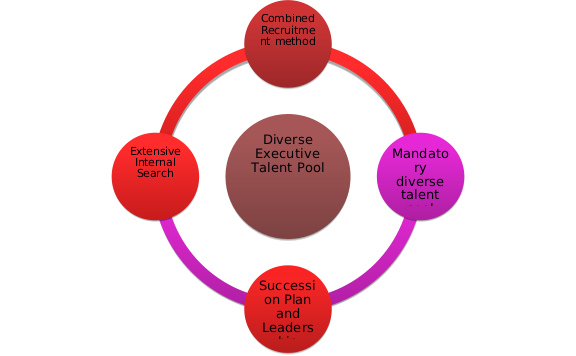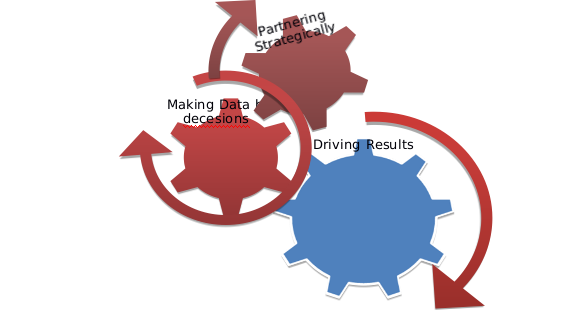External And Internal Sources For Job Recruitment
Google, the US based giant enterprise and British Airways, are two organizations, which have traditionally used an integrated approach of external and internal recruitment policies (Amos, Ristow, Pearse, and Ristow, 2009 ). Both these organizations have been able to blend resources and transform them into a cohesive and uniform organizational culture.
The very basic principle followed and implemented in Google is continuous employee improvement and excellence. The main objectives of Google behind internally promoting existing talents are:
Employee Retention: Over the years, Google has ensured that existing talent pools, within the organization are retained. In order to retain employees, Google practices internal promotions within the organization.
Training: The organization has a culture of robust training programs. However, the training programs are both generic and specific in nature (Schein, 2009). The generic training programs ensure uniformity and updation of the organization cultures among all employees. On the other hand, training programs which are specifically designed are meant for certain sections of the employees, whom the management think-tank wants to hone for higher designations for the future (Martin, Bartol, 2001).
360 degree exposure: Google ensures that the employees do not get restricted to a certain job description or job role for a large extent of time. Rather, the management ensures that the employees explore their potentials by working flexibly at various departments on a rotational basis ( Driskill, Brenton, 2010). Through this culture, the employees get a complete idea about the job structure in entirety, which help them to prepare themselves for promotions within the organization in the future.
Creating awareness: Google has developed an internal online portal called “Magnet” which keeps the employees abreast about the available job and promotion opportunities within the organization.

The organization has been able to balance recruitment from both internal and external sources, largely due to its emphasis on diversity, as an integral part of the entire Human Resource Program, over the years. Diversity, in the case of Google is mainly in the forms of:
- Ethnicity
- Gender
- Age
- Educational background.
A diverse blend of all these criteria has enabled Google to create a “Diverse Executive Talent Pool” within the organization itself. The aspects that have enabled to create this team of potential executives within the organization are:
Extensive Internal Search: The Human Resource Development team of Google keeps abreast of the performances and achievements of the existing employees in their respective job roles. Moreover, one of the key functions of the HRM team is to screen, on a regular basis, the attitudes displayed by employees, while working on projects outside their designated job profiles (Edenborough, 2002). Feedback, based on the evaluation of these criteria help the management to create an extensive list of internal candidates, who will be potentially eligible for future promotions.
Succession Plan and Leadership development: Preference is given primarily to existing employees, while selecting candidates for a particular designation. For this purpose, the HRM team rolls out platform to employees, in order to showcase their leadership skills, so that they can be honed in the future as potential candidates for important designations and job roles(Schawbel, David, 2012).
Mandatory diverse talent pool: Google prefers to build a robust talent pool, mainly from among the existing employees. This is because, the existing employees are already well aware and accustomed to the organizational culture, which can be a beneficial for the company, if and when those employees are designated to managerial level (Pfister, 2009).
Combined Recruitment methods: Google has, over the years, blended acquisition of talent from outside the organization, as well as nurturing and motivating existing employees (Parry,Tyson, 2009). While there has been a steady influx of employees from the external market, the organization has ensured a high retention rate, which has, as a combined effect, resulted in a strong workforce.
External Recruitment: The strong brand name of Google, has ensured a steady inflow of potential candidates from the external market without much initiative (Harzing, Pinnington ,2010 ).
While a strong retention tactics has enabled the organization to retain an internal talent pool, Google has maintained certain well planned strategies to attract potential talents from the outside market:
Online advertising: As per requirement, Google publishes online advertisements, along with specified criteria for certain job roles within the organization. Online advertisements, in most cases, are comparatively cost effective, with a wide reach, in the present age. This medium is well utilized by Google, for their external recruitments.
Campus interviews: While there is always a basic requirement of candidates with engineering backgrounds for Google, it recruits and hires from other educational backgrounds also. During interviews, conducted in universities, to hire fresh recruits, emphasis is laid upon the potential leadership qualities of the candidates, often irrespective of their educational specializations. The basic technical trainings, if required, are provided, once the candidates join the organization (Aamodt, 2012). This flexibility ensures that the availability of a rich pool of leadership talents within the organization. However, when required, first preferences are given to employees from within the organization, before tapping the external market for candidates.
Policies of British Airway Explained in The Following Model

The underlying principle behind the Human Resource Strategies adopted by British Airways has been to ensure a coherent and consistent experience by its passengers in terms of service. British Airways has partnered with a talent management firm named “Lumesse”, in order to streamline the recruitment and retention processes.
Through this strategic partnership, the organization has been able to assimilate the entire recruitment process, both internal and external.
One of the main objective behind this strategic partnership has been to accumulate data regarding the job vacancies, ascertain requisite criteria for candidates for such vacancies and maintain a comprehensive database of the candidates, who have applied for the posts. This holistic data has enabled the Human Resource development team and the management to keep track of the stages of recruitment processes and most importantly the supply and demand gap in the entire recruitment system.
The data provided by its strategic partner, along with the feedbacks of the Human Resource Management team help the management to apply weightage accordingly on either internal or external talent pools.The organization maintains separate portals for its internal and external candidates. One of the most distinctive features, in this regard is that the application forms are designed specifically for various designations. As a result, the candidates, whether internal or external, can access specific tailor made forms, while applying for a specific designation within an organization.
Impact of Regulatory and Legal framework on Recruitment process
Legal and regulatory frameworks have always been vital aspects that have shaped up recruitment and selection process over the years. However, these frameworks have become increasingly sensitive in the past decade or so, as the entire process of candidate selection and recruitment have become complex with the advent of newer technologies (Martin, Bartol, 2001).
Moreover, over the years, employee demands and expectations have been the main driving forces behind the shaping up of legal and regulatory obligations within the organizational frameworks. Change in perceptions and points of views of the employees social economic trends have governed the legal boundaries for organizations.
Impact on recruitment process
A major trend, nowadays, among organizations is to outsource the entire recruitment process to a specialized agency. This, in itself creates a sensitive situation, as by doing this, the organizations may lose a fair amount of control on the recruitment process itself (Edenborough, 2002). It has become imperative, in these scenarios, to update and to make aware, the specialized agencies, to abide by the regulatory and legal aspects while recruiting candidates. Sophisticated techniques like psychometric tests, biometric tests, aptitude tests and work simulations are becoming increasingly common in the recruitment process. Even though these are scientific processes, the increasing complexity can give rise to new legal issues.
Most reputed companies, nowadays, include medical benefits to not only the employees, but also to their family members. This has, in recent years, become one of the major organizational regulations that employees expect from their employers (Ridderstrale, Nordstrom, 2001). Absence of joint medical benefits is considered as major drawbacks by potential candidates. Apart from promotions and benefits offered by the companies, employees nowadays, search for jobs that offer flexible work timings that will allow them to enjoy their personal lives. Thus, work life balance has become a vital regulatory aspect that has transformed into a deciding factor in the recent past. Pressures of expectations from employees and candidates have forced organizations to include this aspect within their regulatory framework.
Selection process
Legal and regulatory impacts are evident on the selection process as well. For example, multinational companies like Hewlett Packard, based in UK have faced complications while recruiting candidates from outside the country in the recent past, as they belong from a different ethnicity. With ever growing job markets, and influx of candidates from across countries, these type of regulatory impacts on selection process are becoming increasingly common.
The psychologies of the candidates, applying for jobs, have also transformed over time. Skilled candidates, nowadays, have become much more demanding in terms of the rewards and perks, as well as the pay scale they expect from their potential employers. This is in stark contrast from an era when employees seek mainly long term securities and permanency. This particular aspect has raised difficulties for organizations to create legal contracts that will satisfy and retain skilled employees on one hand, and stay within the regulatory boundaries on the other.
Perceptions of employees about job dynamism have changed over years. Employees, in the present era, demand a dynamic job environment, where they can continually evolve through training and development programs. Thus, organizations, while selecting skilled candidates, often include these criteria in the legal contracts that are prepared while recruiting. Google, the multinational organization, has, over the years, created a strong brand among employees and potential candidates by offering unique rewards and perks to its employees.
Recruitment process of Sales Assistant and roles of HR Assistant
An advertisement should ideally create the first and lasting impression on the minds of the potential candidates and motivate them enough to delve further into it. Job advertisement can be designed on the basis of AIDA model. The following advertisement has been created for vacancies for Sales Assistant in a retails garments shop.
Vacancy for Sales Assistant
Opportunity to be a part of the success story of the youngest and fastest growing garments retail franchise in UK. Started as a single store in 2010, the brand has fast transformed into a successful franchise. Currently, the brand has 22 stores across UK, major expansion plans ahead.
- Managing counters and selling.
- Cross selling to potential customers.
- Team management.
- Adhering to sales target.
- Inventory management.
- Customer meetings.
Work shifts will be rotational. Apart from the basic duties, the job profile may require teamwork and engagements in other departments, if and when necessary.
Instant assignment help Australia is the leading assignment writing service provider in Australia. Contact their writers for all your assignment and essay writing help requirements.
You may also like to read:
REFERENCES
- Aamodt, Michael, 2012. Industrial/ Organizational Psychology : An Applied Approach. Cengage Learning.
- Amos, Trevor, Ristow, Adrian, Pearse, Noel. J. and Ristow, Liezel, 2009. Human Resource Management. Juta and Company Ltd.
- Bamber, Greg J, Gittell, Jody Hoffer, Kochan, Thomas A. and Nordenflycht, Andrew von, 2013 . Up In The Air : How Airlines Can Improve Performance by Engaging Their Employees.Cornell University Press.
- Banfield, Paul and Kay, Rebecca, 2012. Introduction To Human Resource Management. Oxford University Press.
- Bartol, K. M. and Martin D. C. , 2001. Management. Irwin.
- Crawley,Eileen, Swailes,Stephen and Walsh, David, 2013. Introduction to International Human Resource Management. Oxford University Press.
- Driskill, Gerald W. and Brenton, Angela Laird, 2010 .Organizational Culture in Action: a Cultural Analysis Workbook. SAGE.












